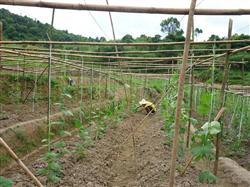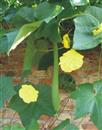How to grow towel gourd

How to grow towel gourd? Please introduce in detail the following methods for towel gourd cultivation: first, select improved varieties suitable for summer cultivation, that is, varieties that are not sensitive to short-day light, such as Xiayu towel gourd, new Xiatang towel gourd, Fengkang towel gourd, Yalu No.1, Xiuyu towel gourd and so on. Second, seedling transplanting summer towel gourd is not suitable for direct seeding, fields with good drainage should be selected to raise seedlings and transplant. Soak towel gourd seeds in water for 10 hours, pick them up and drain them, then sow them. The commonly used sowing methods are plastic nutrition cups and seedling trays to raise seedlings, and the nutrient soil should be new soil or vegetable garden soil that has not been planted with melons. Sow 1 seed in each hole when sowing. Before transplanting seedlings, it is necessary to properly control water to make fertilizer and cultivate strong seedlings. Third, towel gourd like fertilizer should be planted in loam or clay loam with sunny, fertile, moist, high content of organic matter and strong ability of water and fertilizer conservation. 4. Land preparation and planting 1. Land preparation: planting from the border, the width of the border is 1.2 mi 1.5 meters, the width of the ditch is 30 mi 40 cm, and the height of the border is 35 cm. Combined with soil preparation, 2000 kg of soil miscellaneous fertilizer + 50 kg of Norwegian compound fertilizer or 50 kg of western compound fertilizer are applied per mu. 2. Planting: summer towel gourd cultivation adopts double-row planting, the distance between row and plant is 70ml, 80cm × 50cm, and it is suitable to plant about 1700 plants per mu. The seedlings can be transplanted in the field when they have 2 Mel 3 true leaves. 5. Field management 1. Vine leaf arrangement: generally, the first vine is pressed about 35 cm long, and the second vine is about 70 cm long. the direction of the vine can lead to the same direction or relative direction. the method of pressing the vine depends on the weather, and the melon vine is pressed into the ditch on a sunny day. press the melon vine into the ditch and cover with small pieces of soil; on rainy days, press the vine on the border surface without opening the trench to prevent the stem from rotting. In case of continuous rain and stagnant water on the border surface, you only need to press the leaves with mud blocks without pressing the stem vines, which can also fix the roots and prevent the stem vines from rotting. When introducing the vine to the hedge, in order to adapt to the characteristics of the long vine of summer towel gourd, generally wait until the male flower appears before introducing the vine on the hedge, and the zigzag shape is used to evenly lead the vine. In the middle and later stages of growth, the withered or diseased leaves at the base should be properly removed. In the case of overgrowth of vine leaves, some leaves can be removed at intervals in different parts of the upper, middle and lower parts, or in the position where the vine leaves grow too densely, which is conducive to ventilation and light or reduce diseases and insect pests. 2. Timely management of melons: during flowering and fruiting, when melons are found on leaves or hedges, melon vines or tendrils are entangled, they need to be arranged in time, so that they can be suspended vertically in the scaffolding, and diseased melons should be removed at the same time to avoid spreading diseases. 3. Rational fertilization: the general principle of fertilization is: apply thin fertilizer frequently, control water and fertilizer before melon fruit, apply heavy fertilizer after fruit and when lateral vines are in full bloom, and pay attention to the application of phosphorus and potassium fertilizer. Adequate organic fertilizer should be applied and chemical fertilizer should be applied. Organic fat, towel gourd grows straight and long, otherwise it is easy to cause melon strip deformity. For 7 days after transplanting, 5 Mu was drenched with 1500 kg of light feces and urine at 1:10 to promote the growth of stems and leaves. Fertilization will be determined according to the seedling condition from now on to before flowering and fruiting: the seedlings are vigorous and dark green, with little or no fertilization; the growth is weak, applying 4 kg per mu of compound fertilizer 1500 kg every 15 days or 1500 kg of light feces and urine at 1:10. After the result, topdressing fertilizer was applied every 5 kg / mu for 7 days, and compound fertilizer was applied at 10 kg / mu. During the harvest period, the amount of fertilizer should be increased 2 times, and 50 kg / mu of plant ash should be applied twice. 4. Water management: the towel gourd needs more water during the whole growth period, and the soil should be kept moist in the early growth stage. During the flowering and fruiting period, the loofah needs the most water and the root system is strong, so it needs to strengthen irrigation. Towel gourd not only needs water, but also avoid stagnant water, irrigation should be immediately irrigated, not flooding irrigation, especially in rainy days, should pay more attention to drainage, in order to prevent stagnant water. 6. pest control 1. Disease control: control of cataplexy with 70% dimethyclovir 300x solution, 75% chlorothalonil 800x solution or methyl topiramate 800x solution, epidemic disease with 72% Kelu 800x solution or 70% mancozeb 800x solution. Downy mildew was controlled with 58% pyrethromycin 600x solution or 72% klox 750x solution, and powdery mildew was controlled with 2000 fold solution of 20% trimethoprim Anthracnose was prevented and treated with 70% methyl topiramate 800ml 1000 times or 50% carbendazim 1500 times. 2. Pest control: melon silk borer is controlled with 2000 times of mites or Bacillus thuringiensis preparations; melon fruit flies are controlled with 48% Lexben 1000 times, 90% trichlorfon 1000 times or 80% dichlorvos 1000 times; aphids are controlled with 10% imidacloprid 1500 times. Click for more towel gourd planting techniques click to get more vegetable planting techniques
- Prev

What diseases and insect pests should be controlled when planting towel gourd?
What diseases and insect pests should be controlled when planting towel gourd? Please guide the cultivation of towel gourd there are the following diseases and insect pests to control: the main insect pests of towel gourd are: Huang Shou gourd. There are firefly-like insects in towel gourd fields, which is a symptom of Huang Shou gourd damage. Huangshou melon adults bite on plant leaves, stems, flowers and fruits.
- Next

How to dip towel gourd in flowers
How to dip towel gourd in flowers? Please give instructions to the towel gourd dipped in flowers can refer to the following methods: first, determine the dipping time. As the temperature rises, loofah flowers open earlier, it is recommended that vegetable farmers now dip in flower time between 10: 00 a.m. and 3: 00 p.m., otherwise the flowers are big and thin, and customers are not willing to buy them. Two.
Related
- Where is it suitable to grow horseradish in China? it is expected to see the middle altitude horseradish in Alishan.
- How to prevent tomato virus disease reasonably? (Control methods included)
- Many people like to plant towel gourd on the balcony. What are the main points of this method and management?
- What crops can chili peppers be mixed with?
- Fertilization techniques and matters needing attention in Tomato
- What are the grafting techniques for peach seedlings in spring?
- Harm and control methods of root swelling disease of Chinese cabbage
- What are the pests of sweet potatoes? How to prevent and cure it?
- Symptoms, causes and Control methods of navel Rot in Tomato
- The cause of "Cucumber rotten bibcock" in Farmers' planting Cucumber and its Control Plan

